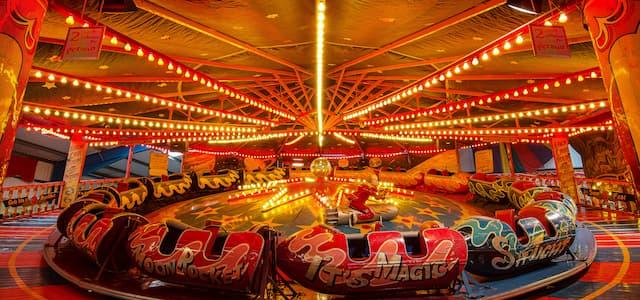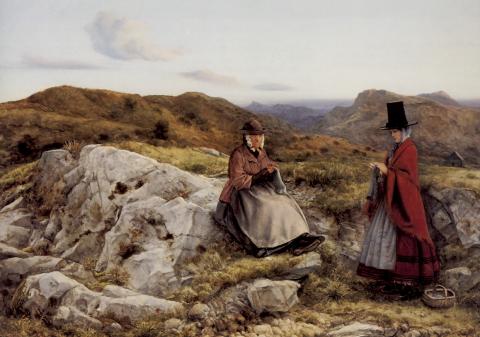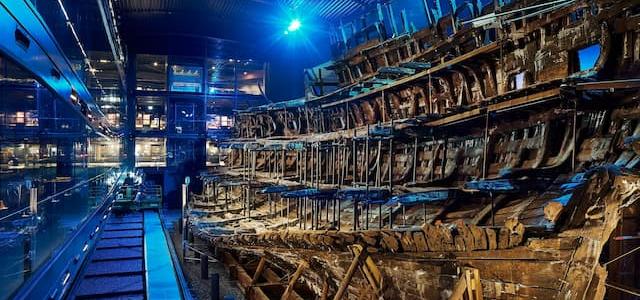
Significant support secures Dyce for Wales
Amgueddfa Cymru - National Museum Wales purchases painting by William Dyce for the nation.

Today (15 June 2010), Amgueddfa Cymru – National Museum Wales announces it is able to save for the nation a painting by William Dyce entitled Welsh Landscape with Two Women Knitting, 1860, thanks to crucial funding grants from the National Heritage Memorial Fund (NHMF), membership charity the Art Fund and others.
Thanks to the generous support of the NHMF and the Art Fund, who each awarded a grant of £166,000, one major private donor, a number of significant gifts and nearly 150 other individual donors, Amgueddfa Cymru has now acquired the painting for £557,218.
Welsh Landscape with Two Women Knitting from the collection of the late Sir David Scott (d.1986) was sold at Sotheby’s, London in November 2008. In November 2009 a temporary export bar was placed on the painting, providing an opportunity for a buyer to raise enough money to keep this important work in the United Kingdom. It has now been saved for the nation by Amgueddfa Cymru, which has had an interest in obtaining the work for some time.
A celebration of Welsh rural life, the painting depicts two women in folk costume into a tightly observed hillside in Snowdonia. William Dyce (1806 – 1864) was originally from Scotland and came to Wales for his health and a ‘change of air’ in 1860. He was immediately captivated by the area. This painting, based on sketched material from his excursion, was probably painted in the studio on his return to London.
The fine depiction of the North Wales landscape illustrates the popularity of the Conwy valley amongst Victorian painters, and can be compared with works by David Cox, Benjamin Leader and Henry Clarence Whaite. Welsh Landscape with Two Women Knitting is also a meditation on the transitory nature of human life and on the passage of time.
The Dyce painting is the only known Welsh subject picture by an artist who absorbed many key Pre-Raphaelite principles. It will now form a part of Wales’ national art collection, which is currently being re-displayed at National Museum Cardiff. Initially, it will be a pivotal element in the Museum’s new Victorian Art display which includes neo-classical sculptures by John Gibson, romantic works by Turner, Landseer and Etty, a fine group of Pre-Raphaelite paintings, works by Burne-Jones and others associated with the Aesthetic movement, as well as genre paintings including William Powell Frith’s Tenby Prawnseller.
Oliver Fairclough, Keeper of Art, Amgueddfa Cymru – National Museum Wales said: “We have hoped for many years that this very beautiful work by Dyce would one day come home to Wales. We are delighted that this has now been achieved and are deeply grateful to NHMF and the Art Fund for their support. Indeed, the exceptional number of individual donors who’ve backed this campaign demonstrates the interest and importance of this work.”
Dan Clayton-Jones, Chair of the Welsh Committee and Trustee of the National Heritage Memorial Fund, commented: “We’re delighted this painting which so vividly captures the essence of the Conwy Valley will now form a part of Wales’ national art collection. This grant continues NHMF’s support for the museum - now over £3.2million - which has enabled them to secure a range of Welsh treasures including the Wynnstay Organ, William Hogarth’s The Jones Family and the Jackson Silver. This historically precious painting will now join the diverse range of the UK’s most important heritage safeguarded by the NHMF over the last 30 years.”
Over the last ten years, the Art Fund has given over £1.2million to Amgueddfa Cymru – National Museum Wales to help them acquire work by celebrated artists including Sir Joshua Reynolds, Alfred Sisley and Pablo Picasso, as well as internationally acclaimed contemporary artists Eija-Liisa Ahtila, James Turrell and Betty Woodman.
Stephen Deuchar, Director of the Art Fund added: “We are very pleased to have given £166,000 to National Museum Wales to help them secure this significant work by Dyce. It's a perfect example of how private and public money can work in tandem to secure great works for public enjoyment. Art Fund members have helped the Museum to make some major acquisitions in recent years and we're delighted that the Dyce is now part of that collection.”
National Museum Cardiff is one of Amgueddfa Cymru – National Museum Wales’ seven national museums. The others are St Fagans: National History Museum, the National Roman Legionary Museum, Big Pit: National Coal Museum, the National Wool Museum, the National Slate Museum and the National Waterfront Museum.
Entry to each Museum is free thanks to the support of the Welsh Assembly Government.
Notes to editors
William Dyce (1806-1864) was born and brought up in Aberdeen and considered careers in medicine and the church before deciding to become a painter. He studied in Rome in 1825-6, and returned to Italy in 1827-8. While there he was influenced by the art of the Nazarenes, a community of German painters based in Rome, whose interests in reviving Renaissance art, early religious music, and theology closely mirrored his own developing tastes. Dyce settled in Edinburgh in 1830 where he worked as a portrait painter especially of women and children. He also became increasingly interested in naturalistic landscape painting especially of Scottish highland subjects.
In 1837 he moved to London and became Head of the newly-established Government School of Design (later the Royal College of Art), and although he resigned in 1843, the Victorian ‘South Kensington system’ of Art education was largely based on his ideas. He was also deeply interested in the National Gallery, arguing that the collection should provide an overview of the development of art encompassing all periods. However, his personal allegiance was to the ‘Italian Primitives’ of the fourteenth and fifteenth centuries, admiring their ‘freshness of thought and intention’.
He worked extensively at the new Palace of Westminster as a fresco painter and on the decoration of high Anglican churches. As a senior Royal Academician in the 1850s, he was an important supporter of the Pre-Raphaelites’ aim to renew English art. Early Pre-Raphaelite painting also influenced his later work which is full of highly realistic plants and flowers. In George Herbert at Bemerton (1861; Guildhall Art Gallery, London) Dyce adopted the Pre-Raphaelite practice of painting on the spot, recording the peaceful English garden of the seventeenth-century Welsh divine and poet. His best-known work, Pegwell Bay (1858, Tate) is Pre-Raphaelite in its recording of the flint-encrusted strata and eroded faces of the chalk cliffs near Ramsgate. Dyce was not previously represented in the collections of Amgueddfa Cymru.
Further information
For further information, please contact Catrin Mears, Communications Officer on 029 2057 3185 / 07920 027067 or email catrin.mears@museumwales.ac.uk.

